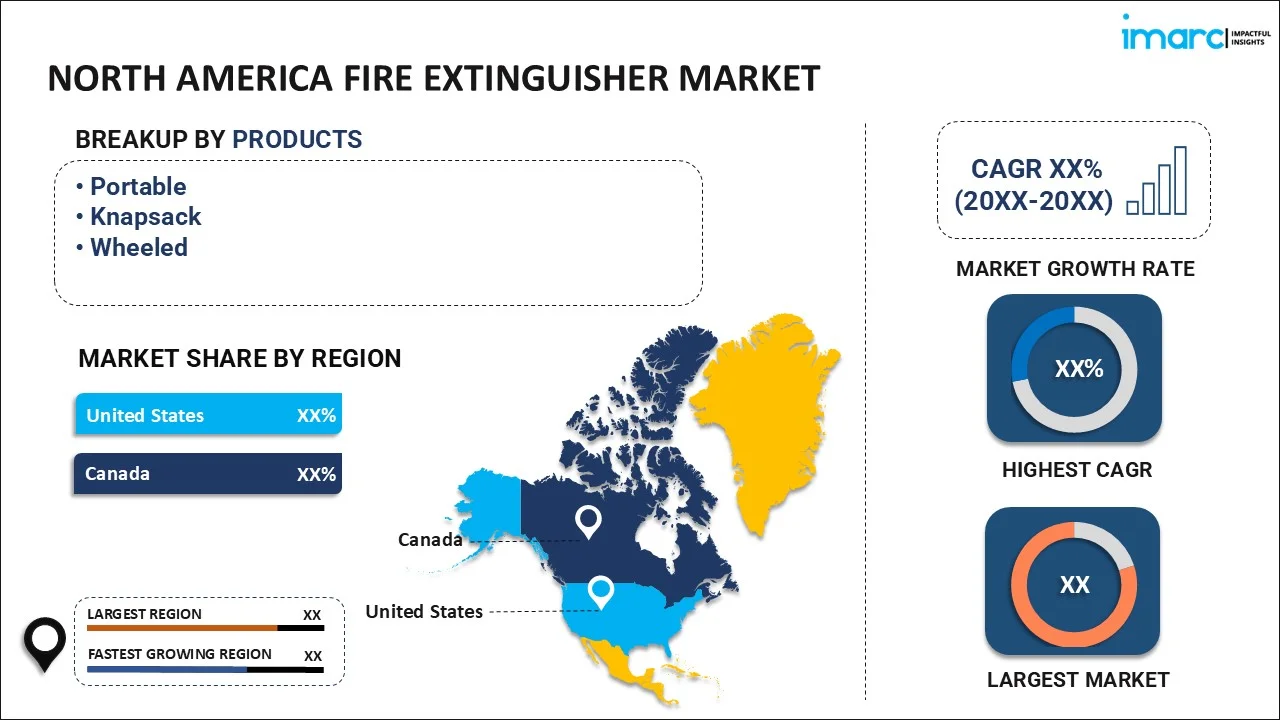
North America Fire Extinguisher Market Report by Product (Portable, Knapsack, Wheeled), Extinguishing Agent (Dry Chemicals, Foam, Carbon Dioxide, and Others), Fire Type (Class A, Class B, Class C, and Others), Application (Industrial, Commercial, Households, Public Areas, and Others), and Country 2025-2033
Market Overview:
The North America fire extinguisher market size reached USD 1.62 Billion in 2024. Looking forward, IMARC Group expects the market to reach USD 2.09 Billion by 2033, exhibiting a growth rate (CAGR) of 2.77% during 2025-2033.
|
Report Attribute
|
Key Statistics
|
|---|---|
|
Base Year
|
2024
|
|
Forecast Years
|
2025-2033
|
|
Historical Years
|
2019-2024
|
|
Market Size in 2024
|
USD 1.62 Billion |
|
Market Forecast in 2033
|
USD 2.09 Billion |
| Market Growth Rate 2025-2033 | 2.77% |
A fire extinguisher is a movable or portable fire protection apparatus used for putting out small fires. It is generally kept at different fire points in factories, buildings, vehicles and public spaces. The device interferes with the fire triangle made of three elements which are required to create a fire, namely, fuel, oxygen and heat. At present, carbon dioxide (CO2), dry chemical, foam-based extinguishers are the different types of fire extinguishers available in the market.
The North America fire extinguisher market is currently being driven by various factors. Most of the demand for fire extinguishers is emerging from the construction sector, which includes both residential as well as commercial units. Therefore, rapid development in the construction sector across the region is having a positive impact on the growth of the fire extinguisher market. In addition to this, various transportation owners have started installing fire suppressant equipment in broad vehicles, such as buses, to ensure the safety of passengers. Moreover, numerous regulations and initiatives have been implemented by the government in the region to mandate the provisions of fire protection which is fueling the demand for fire extinguishers in the region.

Key Market Segmentation:
IMARC Group provides an analysis of the key trends in each segment of the North America fire extinguisher market report, along with forecasts at the regional and country levels from 2025-2033. Our report has categorized the market based on product, extinguishing agent, fire type and application.
- Key Regions Analysed
- United States
- Canada
- Analysis for Each Country
- Market by Product
- Portable
- Knapsack
- Wheeled
- Market by Extinguishing Agent
- Dry Chemicals
- Foam
- Carbon Dioxide
- Others
- Market by Fire Type
- Class A
- Class B
- Class C
- Others
- Market by Application
- Industrial
- Commercial
- Households
- Public Areas
- Others
- Value Chain Analysis
- Key Drivers and Challenges
- Porters Five Forces Analysis
- Competitive Landscape
- Competitive Structure
- Key Player Profiles
Report Coverage:
| Report Features | Details |
|---|---|
| Base Year of the Analysis | 2024 |
| Historical Period | 2019-2024 |
| Forecast Period | 2025-2033 |
| Units | Billion USD |
| Segment Coverage | Product, Extinguishing Agent, Fire Type, Application, Country |
| Countries Covered | United States, Canada |
| Customization Scope | 10% Free Customization |
| Post-Sale Analyst Support | 10-12 Weeks |
| Delivery Format | PDF and Excel through Email (We can also provide the editable version of the report in PPT/Word format on special request) |
Key Questions Answered in This Report
The North America fire extinguisher market was valued at USD 1.62 Billion in 2024.
We expect the North America fire extinguisher market to exhibit a CAGR of 2.77% during 2025-2033.
The extensive R&D activities to launch compact, lightweight, and cost-efficient fire extinguishers are primarily catalyzing the North America fire extinguisher market.
The sudden outbreak of the COVID-19 pandemic had led to the implementation of stringent lockdown regulations across several nations of North America resulting in temporary closure of numerous manufacturing units and supply chain disruptions of fire extinguishers.
Based on the product, the North America fire extinguisher market has been segmented into portable, knapsack, and wheeled. Currently, portable fire extinguisher holds the majority of the total market share.
Based on the extinguishing agent, the North America fire extinguisher market can be divided into dry chemicals, foam, carbon dioxide, and others. Among these, dry chemicals currently exhibit a clear dominance in the market.
Based on the fire type, the North America fire extinguisher market has been categorized into class A, class B, class C, and others. Currently, class A fire accounts for the largest market share.
Based on the application, the North America fire extinguisher market can be segregated into industrial, commercial, households, public areas, and others. Among these, the industrial sector currently holds the majority of the total market share.
On a regional level, the market has been classified into United States and Canada, where the United States currently dominates the market.
Need more help?
- Speak to our experienced analysts for insights on the current market scenarios.
- Include additional segments and countries to customize the report as per your requirement.
- Gain an unparalleled competitive advantage in your domain by understanding how to utilize the report and positively impacting your operations and revenue.
- For further assistance, please connect with our analysts.
 Inquire Before Buying
Inquire Before Buying
 Speak to an Analyst
Speak to an Analyst
 Request Brochure
Request Brochure
 Request Customization
Request Customization




.webp)




.webp)












